



Suggested citation: Abraham, Sijo, Ekansha Khanduja, Shreya Wadhawan, Shravan Prabhu, Shanal Pradhan, Kartikey Chaturvedi, Apoorve Khandelwal, and Nitin Bassi. 2024. Policy study on Re-calibrating Institutions for Climate Action. Jaipur: Chief Minister's Rajasthan Economic Transformation Advisory Council; Council on Energy, Environment and Water.
Climate change is creating significant risks for people, livelihoods and the economy of Rajasthan, particularly to water and food security. The UN estimates India's climate inaction over the past two decades incurred direct costs totalling INR 13.14 lakh crore (USD 179.5 billion). This complex problem of climate change requires multi-departmental action in convergence with the other non-state actors.
Therefore, the state needs to transition to a much more responsive, targeted, and coherent institutional response to mitigate, adapt, and build resilience to the adverse impact of climate change. Given these complexities, the Chief Minister's Rajasthan Economic Transformation Advisory Council (CMRETAC), under the chairmanship of the chief minister, commissioned the Council on Energy, Environment and Water (CEEW) to execute the following:
Climate change is creating significant risks to people, livelihoods, and the economy of Rajasthan, particularly with regard to water and food security. Since 2000, there has been a six-fold increase in the frequency and intensity of extreme droughts, four-fold rise in those of extreme floods, and four-fold spurt in those of cyclones in the state. Around 88 per cent of the districts are exposed to extreme droughts/drought-like conditions and 27 per cent to extreme floods. Moreover, multiple districts are witnessing a swap of extreme weather events: drought-prone districts are becoming flood-prone and vice-versa. In summary, a vast part of Rajasthan is exposed to climate risks, which are materialised with higher frequency and intensity, impacting every district/region differently (Mohanty and Wadhawan 2021).
At the same time, lack of disaster preparedness entails a very heavy cost. As per UN estimates, the direct costs of India’s lack of climate action to combat climate change and its impacts in the last two decades amounted to INR 13.14 lakh crore (USD 179.5 billion). Therefore, it is imperative for the state to transition to a much more responsive, targeted, and coherent institutional response to mitigate, adapt, and build resilience to adverse impacts of climate change. To enable such a climate action in the state, the Chief Minister’s Rajasthan Economic Transformation Advisory Council (CMRETAC), under the chairmanship of the chief minister, commissioned the Council on Energy, Environment and Water (CEEW) to conduct this scoping study to identify the following: (i) which institutions need to be recalibrated; (ii) what are the recalibrations required; and (iii) how can the recalibrations be executed.
We employed a four-step consultation process to assess the capacity of the relevant state departments, identify the strategies to address the capacity gaps, and prioritise the strategies to form a phased road map (Figure ES1).
Figure ES1 Consultation framework for the study

Source: Authors’ compilation
In the first consultation, officials from the relevant departments assessed the ability of the existing institutions governing the state’s disaster management, agriculture, and ii water sectors for climate action (mitigation, adaptation, and resilience). For this assessment, we employed a Capacity Assessment Framework (CAF) consisting of 8 indicators and 19 sub-indicators (Figure ES2).
During this consultation, we also focused on understanding the effectiveness of various existing climate-relevant policies (policies, schemes, or programmes are collectively referred to as policies in this section) in the agriculture, environment, and water sectors. Overall, 26 policies from the water sector and 63 from the agriculture sector were considered in the assessment.
Figure ES2 Synthesised Capacity Assessment Framework
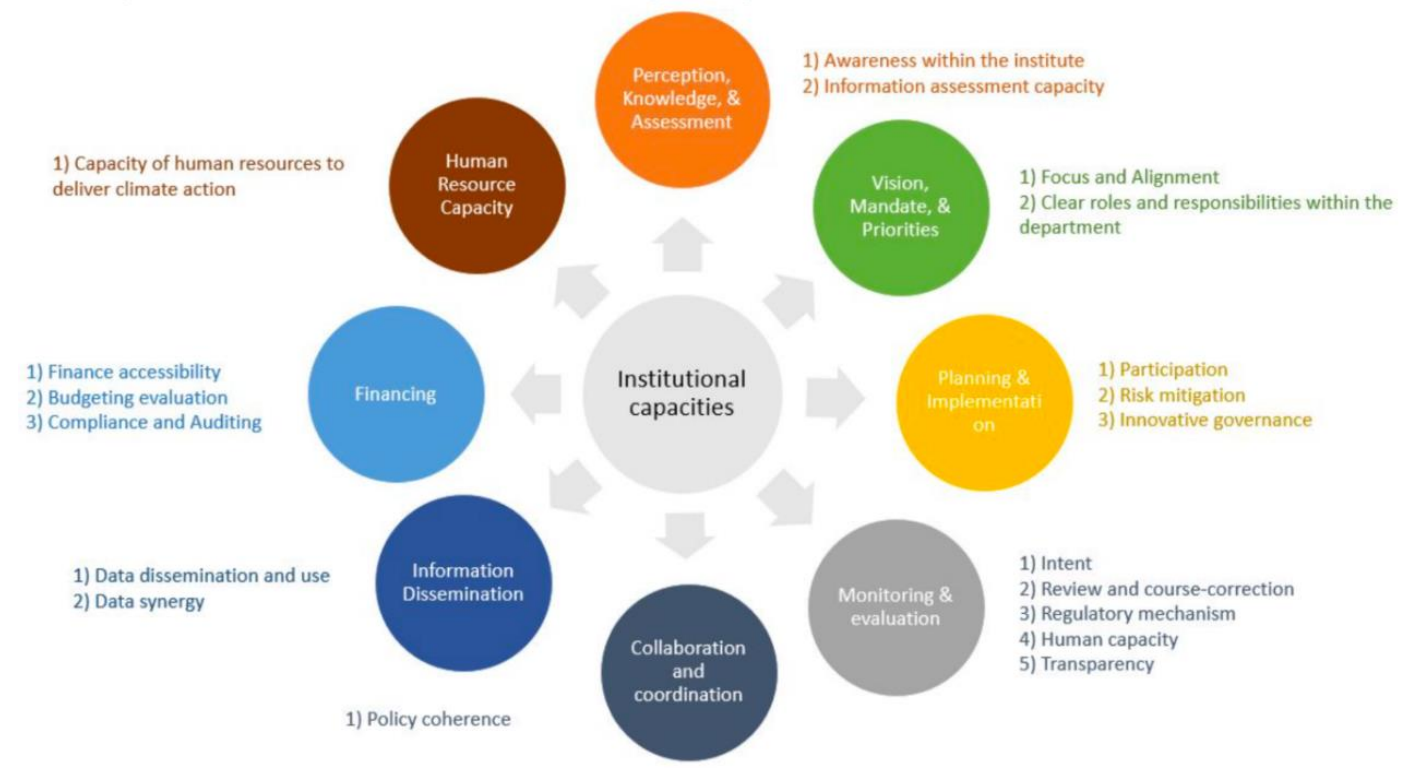
Source: Authors’ synthesis
The second consultation involved a multi-departmental meeting to validate the capacity gaps identified in the previous consultation. In the third round of consultation, we conducted key informant interviews (KIIs) with 29 key officials from 14 relevant departments to develop a long list of interventions that addressed the capacity gaps. The fourth consultation was a two-part workshop aimed at prioritising the identified interventions. The first part of this multi-departmental consultation focused on scoring the state-level interventions on the expected lead time required to implement them. The second part of the workshop was focused on scoring the sectoral interventions on their potential impact and expected lead time to implement.
Figure ES3 Cluster classification on the effectiveness of agriculture and allied policy implementation and design scores received through stakeholder consultations
Source: Authors’ synthesis
Figure ES4 Cluster classification on the effectiveness of water sector policy implementation and design scores received through stakeholder consultations
Source: Authors’ synthesis
Figure ES5 Key capacity gaps that emerged after round 1 of consultations with six departments of the agriculture sector of the Government of Rajasthan
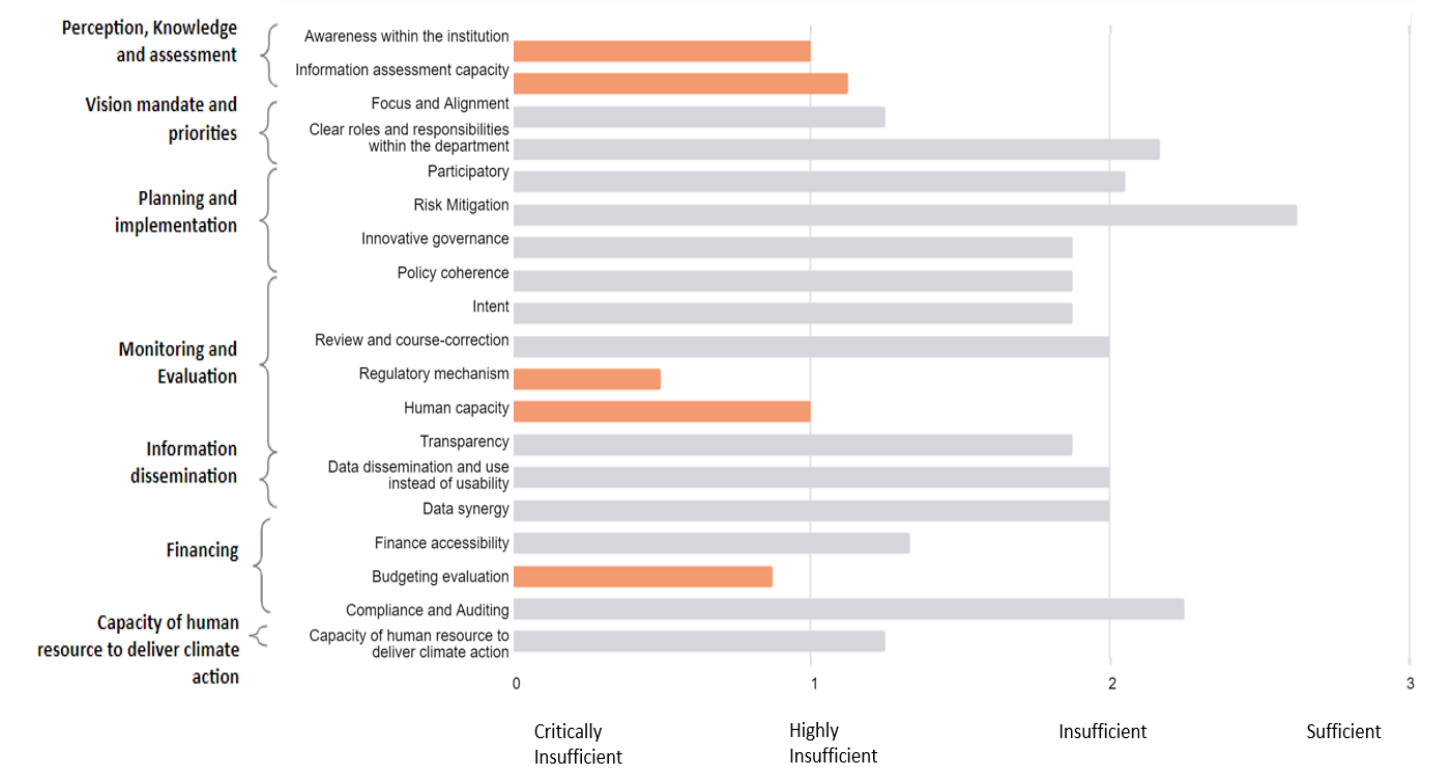
Source: Authors’ compilation
Figure ES6 Key capacity gaps that emerged after round 1 of consultations with six departments of the water sector of the Government of Rajasthan
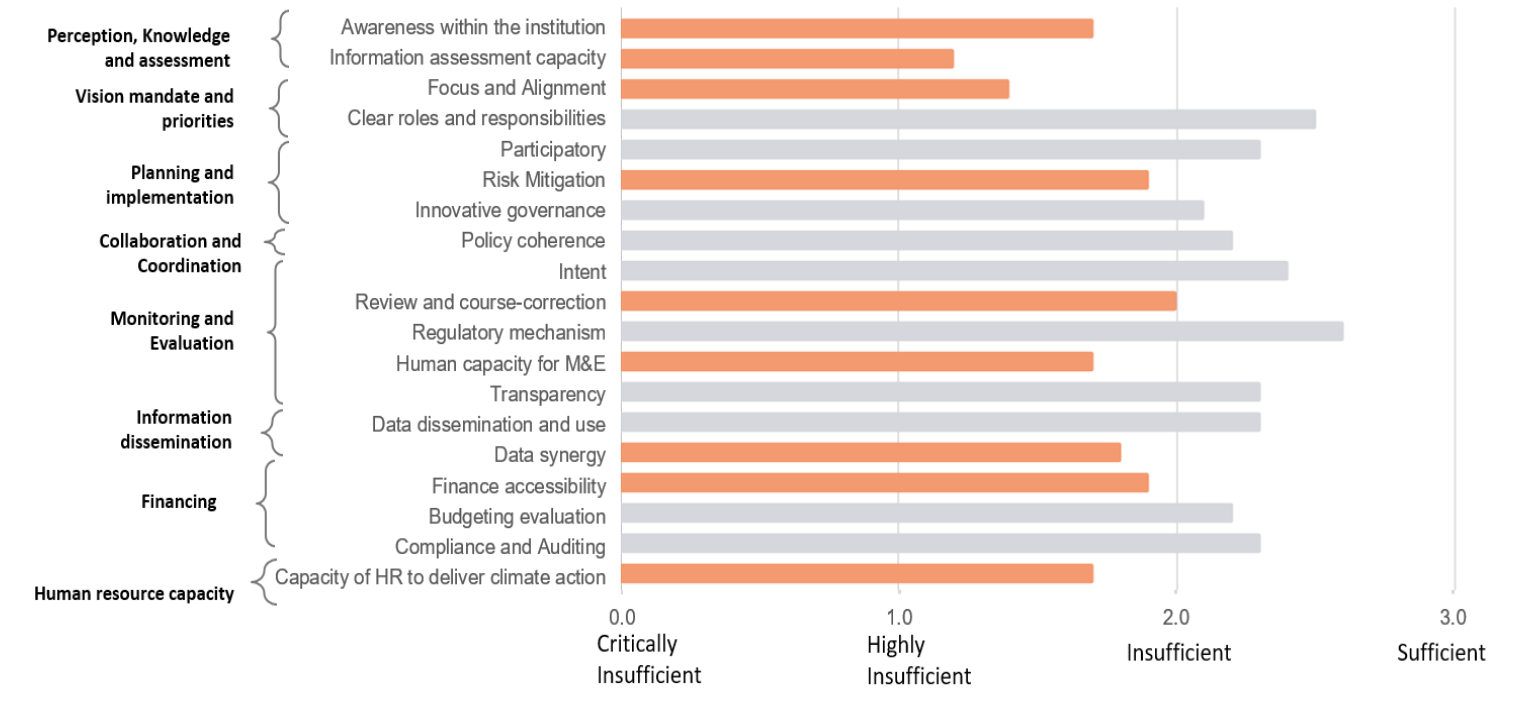
Source: Authors’ compilation
Figure ES7 Key capacity gaps that emerged after round 1 of consultations with State Disaster Management Authority (SDMA), Rajasthan
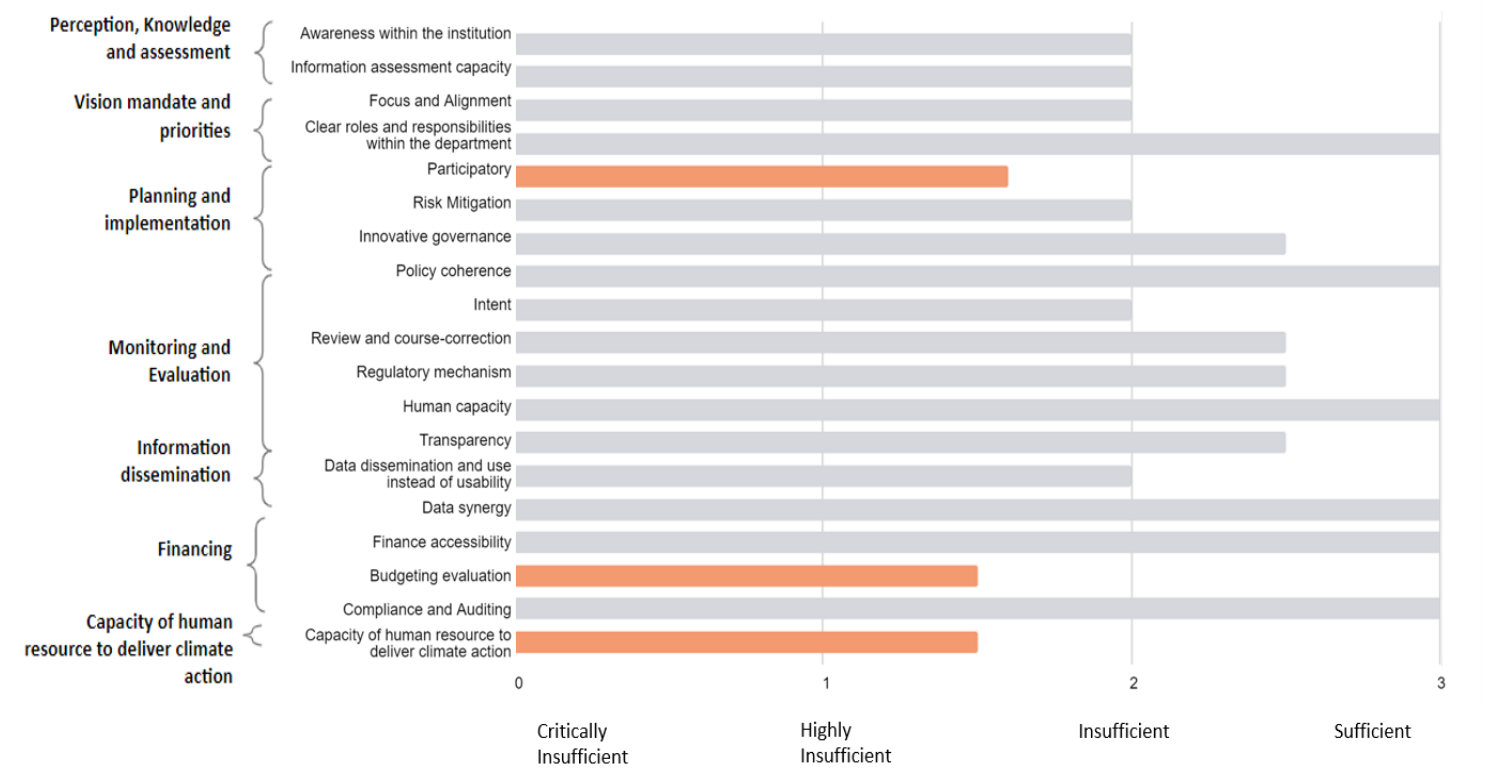
Source: Authors’ compilation
Figure ES8 Impact and feasibility assessment scores of the identified agriculture-sector interventions
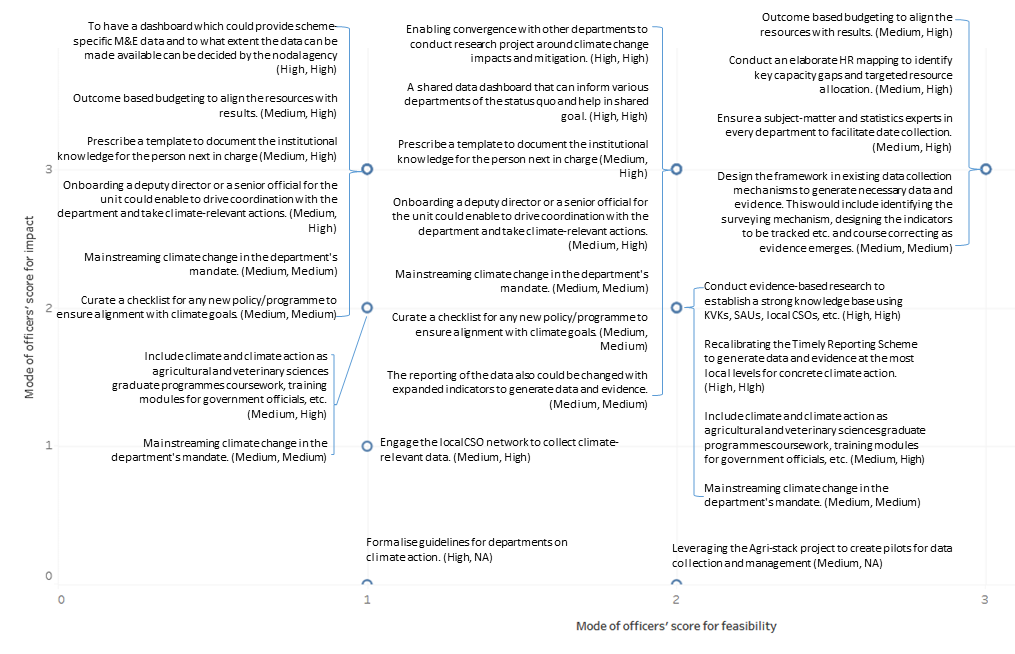
Source: Authors’ compilation
Figure ES9 Impact and feasibility assessment scores of the identified water-sector interventions
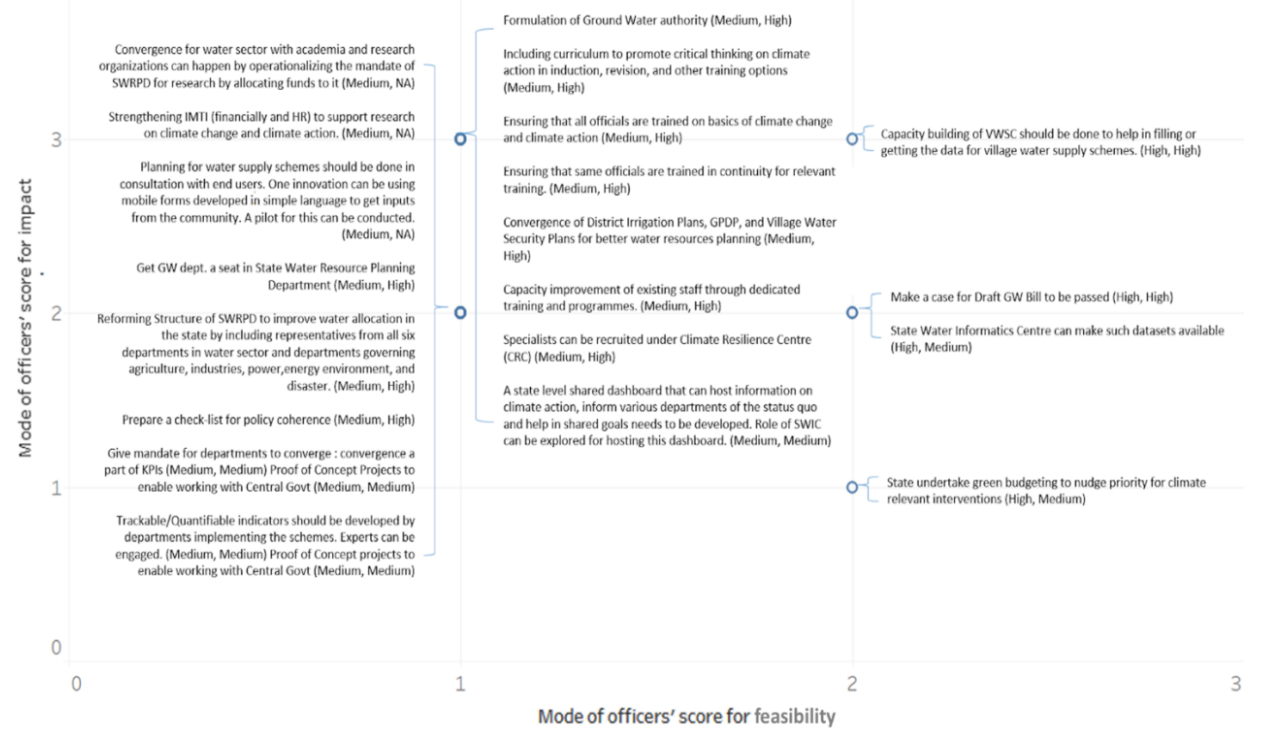
Source: Authors’ compilation
Figure ES10: Impact and feasibility assessment scores of the identified disaster management sector interventions
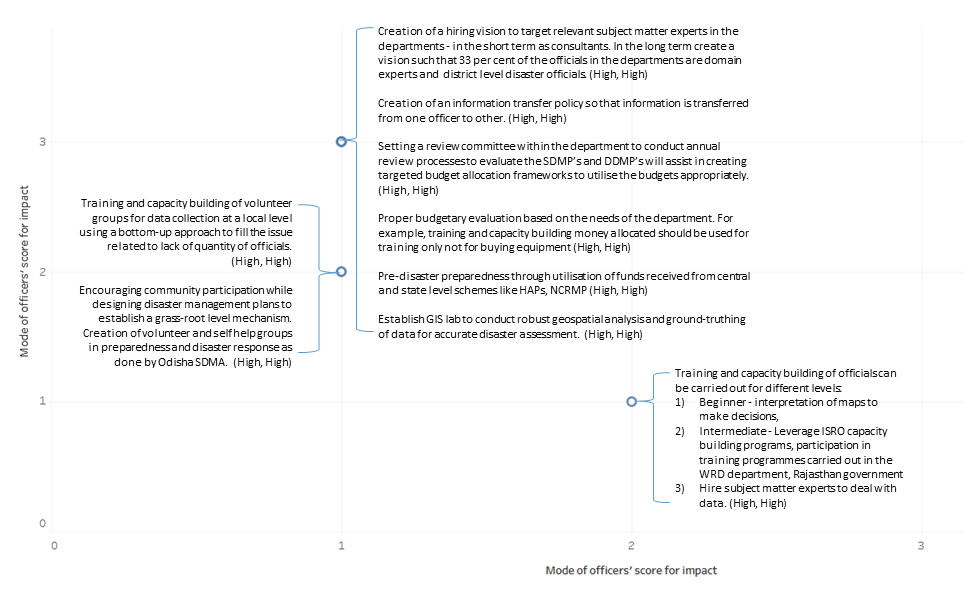
Source: Authors’ compilation
The immediate next step for the state is to develop an actionable plan for the individual interventions identified in this scoping study. The deep-dive workshop on ‘recalibrating agriculture support to climate action’ demonstrated that that the plans to pursue the recalibration interventions should focus on one of the below-listed three purposes, based on the intervention characteristics, such as the expected lead time to implement, risk associated/investment required in the implementation, level of consensus among the stakeholders on the effectiveness of the intervention, and level of clarity on the Rajasthan-appropriate design of intervention:
Table 10 presents the recommended focus of the action plans for different interventions, taking a few example interventions that were deliberated during the deep-dive discussions.
This scoping study comes at an opportune time. As the Government of Rajasthan starts the five-year term in 2024, Rajasthan must embark on this ambitious and pioneering effort of recalibrating governance for responsive, targeted, and coherent climate action and set an inspiring model of transformation for other states.
Table 10 Key focus of action plans to take ahead the different kinds of recalibration interventions
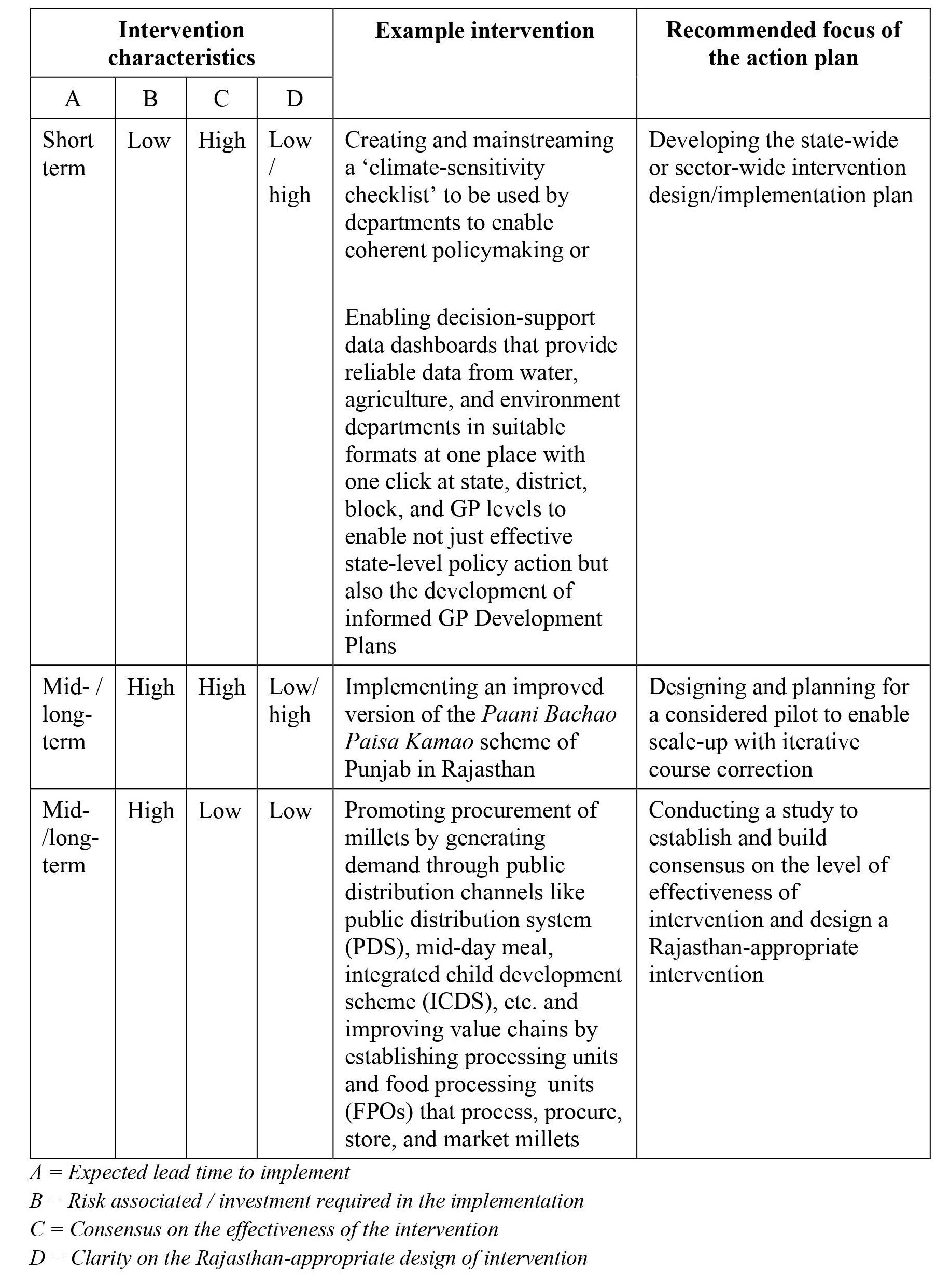
According to CEEW analysis using Indian Meteorological Department (IMD) data, the annual mean temperatures in the state show a significant increase over the last 50 years (1971–2020) by nearly 0.3–0.6°C across all of its districts. Further, most of the districts in Rajasthan are showing an increasing trend in monsoon rainfall. These rapidly changing rainfall and temperature patterns have led to an increase in the frequency of extreme events in the state as well as erratic swapping trends. This can be further substantiated by the fact that Around 88 per cent of districts in Rajasthan, which are home to 68.6 million people, are vulnerable to drought or drought-like conditions.
States are experiencing higher variability in the climatic conditions. A CEEW study has found that there has been a six-fold increase in the frequency and intensity of extreme drought events since 2000 and a four-fold increase in the frequency and intensity of extreme flood events since 2010 (Mohanty and Wadhawan 2021). These unexpected shifts in climate risks pose a lot of threats to lives and livelihoods. State climate action plans are a framework of state action towards changing climate across various sectors. These plans strategically synthesise vulnerability, risks, and the state’s approach to adapting and mitigating these risks.
The State's Action Plan on Climate Change (SAPCC) has identified the state’s current climate and socioeconomic status and highlighted the future risks due to climate change. The report also highlights key mitigation opportunities across agriculture, water, energy, human health, forest and biodiversity, etc. sectors. The report states that Rajasthan is witnessing a concerning trend in groundwater levels in the northeastern districts, namely Jaipur, Dasra, Alwar, and Sikar. Further, the plan states a significant decrease in groundwater, indicating rapid depletion as the situation worsened further between 2017 and 2020. This regional water scarcity issue will likely worsen due to the overexploitation of groundwater and the impact on the agriculture and animal husbandry sectors.
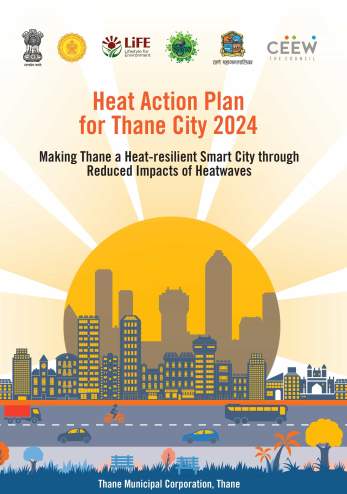
Heat Action Plan for Thane City 2024
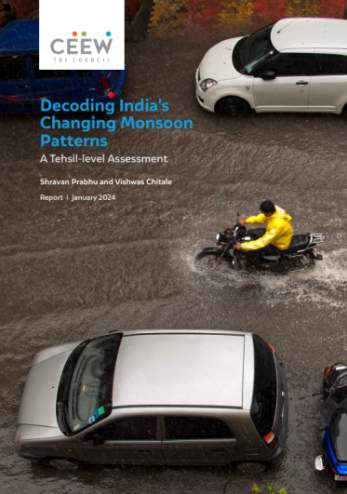
Decoding India’s Changing Monsoon Patterns
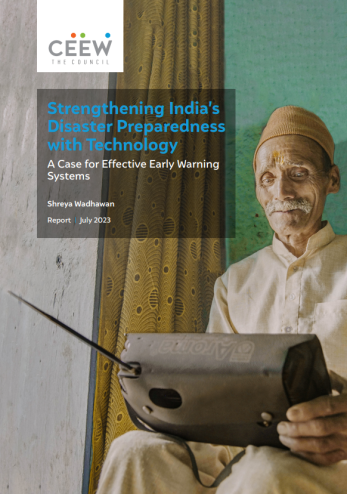
Strengthening India’s Disaster Preparedness with Technology
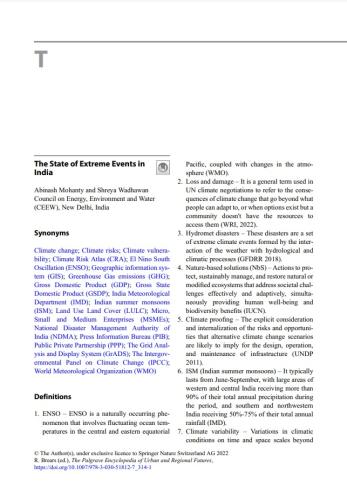
The State of Extreme Events in India